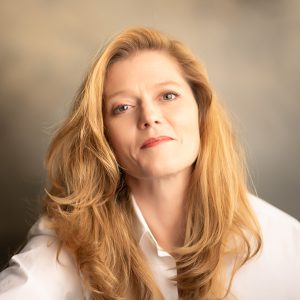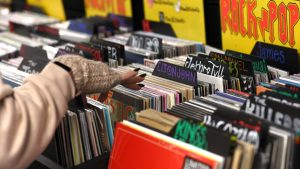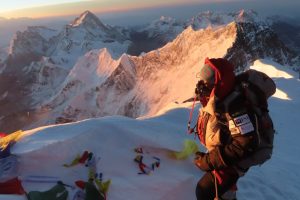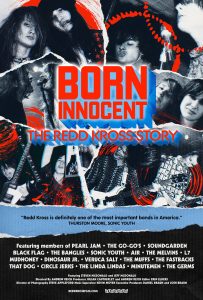Collapsing Time • VAN Magazine
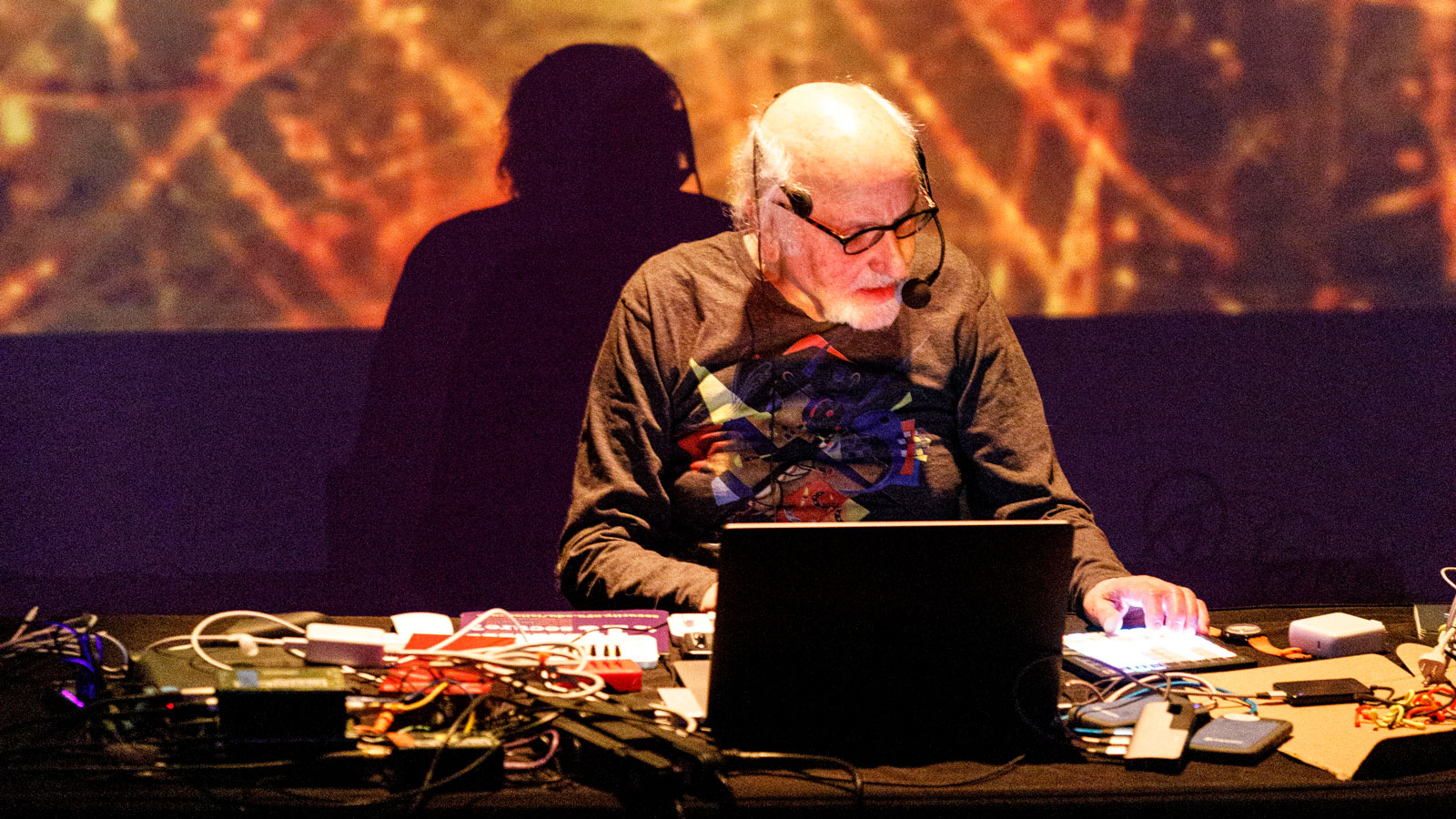
A pioneer of modern electronic music, Morton Subotnick not only encouraged technical innovations but defined new sonic paradigms for the creation of electronic music. Approaching his 90th year in April, he remains as energized and dynamic as ever. As a tech geek and extreme music fan during my high school years in the late 1960s, I liked the idea of electronic music more than the actuality of what I was hearing from such places as the Columbia-Princeton studios. Listening to Subotnick’s “Silver Apples of the Moon” exploded everything in the best way. The work made it clear that Subotnick understood pulse and physicality as many academic composers never could. His followup album, “The Wild Bull,” was a powerful anti-war statement, visceral and exciting. I continued to follow Subotnick’s work and our paths crossed many times over the years. In March 2022, he performed a monumental concert with the Berlin-based video artist Lillevan at the Abrons Art Center in New York’s Lower East Side. I spoke to him after the performance. Subotnick has an exceptional memory, and our talk was extremely detailed.
VAN: How would you describe your approach to performing with live electronics?
Morton Subotnick: My metaphor for the live performance is a conductor. I’m the conductor and the composer and the orchestra, and the orchestra is already playing. I don’t play the orchestra, I conduct them. I play at the highest level: who is gonna play what, when and how. And I can do that and think and process, but if I’m doing this or that with a button, my brain is now located at the end of my finger, not on the whole score.
It’s taken me a while to figure that out, to get that metaphor straight, and it’s very clear now, so I prepare my work that way. That’s where the whole notion for the Buchla was [speaking of Donald Buchla’s first synthesizers, made in 1964–65—Ed.]. It was this machine that was more like an analog computer than a musical instrument. The big change was after I did “The Wild Bull.” I realized with all the ability to move your fingers and do all that, I left a very important control voltage out: my voice. So I called Don and told him I needed a control voltage from my voice. He said, “Oh, I can do that.” And I think it was less than two weeks, and I had an envelope follower so I could turn my voice into a control voltage: I could do real-time control of files and started to build control tracks. So now I could make a thing where I was going, Ooo, Uh, Ooo, a, and it would go, Trtrddtrde.
Do you think that a particular use of electronics in contemporary music was inevitable?
Talking 1959–61: At that time, all of us, including myself, imagined music as marching on, all the way back to Schoenberg and the first part of the 20th century where he was saying, “Now that I’ve made the 12-tone technique, I’m assuring the grandeur of the German composer for 100 years.” Boulez and those guys, Berio and all, they started with Schoenberg and then they discovered Webern. Boulez wrote an article that starts “Schoenberg is dead—long live the king!” The king was Webern, and that was the beginning of the post-Webern movement. When you look back, that’s like 30 years after. [Webern] didn’t even make it to 100 years, but they thought that was the future! So when you get to the beginnings of electronics, even Stockhausen and his earliest [electronic] work, the “Studies,” were all basically post-Webern technique. The only thing he changed is that he did it with oscillators and made fresh tunings. But they’re really dull.
There was no concept of rhythm or meter either.
They got rid of the name! I don’t use meters either, but they got rid of the concept of a meter and said “duration.” Time was duration, not beats. I don’t use meters either because I don’t like dance music, but I do use pulse, and the resulting beats have more wildly varying meters than Stravinsky. They’re regenerating new beats all the time, new accents. When I did “Silver Apples,” I was after a new era, with a new new music, not a new old music. You couldn’t do it; you can’t do new new music with an instrument that already exists. You can say, Play whatever you want on a piano, but the tuning and its sound and the way it operates, it belongs to an older time. You need a new instrument for it, and so the only way to do that was to create something where you could make new instruments for every piece. I was trying to figure out what the fuck new new music is…and I realized I didn’t know.
What I know now that I didn’t know then is that it’s not possible. We’re not geared to it, because music is part of us—we get it so early in life that we’re not geared to something new. When I started “Silver Apples,” I began to make new metaphors for music, and I said, A piece of music is not a piece of music, it’s a record. There’s Side One and Side Two, and you could do either side. Side One will be about pitch, Side Two will be about time.
The very opening of it is an excellent example, where there’s scat singing. That’s where you get the jazz, it was bebop [scat sings]. And I called that “pitches which are disjointed,” they’re not connected to each other. Then I had another take which was “pitches which are close to each other.” They were scalar, but they weren’t in scales. I had nothing that could make a scale so I was doing it all by ear. Then the second side. I said, “Well, where do I go? This would be a good place for a sequencer: I’ll get a kind of groove going.” And I got it set up and then I played it. It took me from two weeks to a month-and-a-half for each section, it took me 13 months to make “Silver Apples.” And in each of these little recording sessions, I would have a patch that would be going continually, because if I turned it off, I didn’t know what would happen. I had the little groove pattern going that was different to start with, but it didn’t have an absolute meter until after about two or three days and I then pruned it down. It blew my mind! I couldn’t get my body off of it, it was just great because it was not just a beat and not just a groove, I mean I grooved it, so it was just the right tempo and I played with it, so it was all there, plus I had another sequencer that would just bring in another beat, a low note. Anyway, so there it was…but it wasn’t the end.
How did you develop “As I Live & Breathe” with Lillevan?
We never had a strategy because the whole idea of the piece was very short and simple: I start out with a breath with the light on me, and as I actually breathe, the first sound, there’s silence and darkness. Then he makes an image. Silence, darkness, and then I do it again and so does he. Then as we repeat we begin to collapse the time until there’s no time at all between our actions. He takes a cue from me when I interrupt him as I’m beginning to do it. I’ve added more material now because it was rather crude the first time. But that’s the only strategy we have between us: I give him what I’m doing when I think of what I’m doing. He develops his stuff separately and then we come together.
Did your work intersect with that of John Cage and David Tudor?
At the Tape Center we did a Cage & Tudor Festival in 1963 because the University of California-Berkeley had decided you couldn’t use John Cage’s name in a music class—because it wasn’t music and it took away from what they were doing! So we got hold of Cage and Tudor. I’d never met Cage. We did a six or seven day festival with a concert every night, and Pauline Oliveros and Ramon Sender and I traded off, running the Tape Center. It was Pauline’s turn to do publicity and she did it like mad: We were on CBS television. When we got to concert time, our auditorium only sat 100 people, and people were in line around the building, so we had to repeat it at 11 o’clock at night. We filled the auditorium six or seven nights in a row, two nights, two concerts, and the second concert started at 11:30 at night, because David was so slow setting up. We were just going crazy.
At the last concert, we did Cage’s “Concert.” It’s all the instruments, we had about 11, 12, 13 instruments. His view was that you take a task on, you do it the best you can, and as truthfully as you can. He changed the instructions from time to time because they didn’t work, but that was because they were incomplete. When you get to something like the one with the electronics in it, “Cartridge Music,” that’s really complete. You would do exactly what he says and nothing else, not because he’s imposing himself, but he’s making instructions that will allow…he just hated the idea of improvising.
Articles like this, straight to your inbox
Processing…
Success! You’re on the list.
Whoops! There was an error and we couldn’t process your subscription. Please reload the page and try again.
So did Morton Feldman.
Yeah, I was with him when he did “Piano,” I think that was one of the first, if not the first long piece. I was staying with him in his little apartment in Buffalo for a couple of weeks when he was writing it. I would go in and he would be playing and have his cigarette dangling with the ash falling on the keyboard, and he would play over and over until he could get each chord—tuung!—just the right dynamic so that he was really happy with it and then put it in the score. That started him on this approach. He had done the open form pieces where he just did numbers and things, and he was one of the first to convert to writing everything down.
He was really important to us at that time. I got to know him extremely well. At one point when I was teaching at CalArts, I was starting to pull away. I was going to go to half-time, and my relationship with the school was always such that I was close to the president and they would listen because I had helped start the place. I said, “I want my contract to remain intact, but I’m not gonna be here the second term. I want to choose who comes in.” They agreed to that. So I think the first person I chose was Morty and I got a call from him, and he said he’d just found out that I had wanted him to be there but I wasn’t gonna be there when he was coming. He said, “Can we have lunch?” He said it was very important. So we went to lunch and he started talking as he did, and I said, “Morty, you just wanna tell me something important, you better do that now, before you forget,” and he looked at me and said, “Why aren’t you coming in to teach?” I said, “Well, I don’t have to. We’re living cheaply and I’m making enough from my work that I don’t have to come in and teach.” Then I mimicked him: “And why are you coming in to teach? You don’t need to.” He said, “I’m lonely.”
Even at the time, I’m still touched by the way he said it. These are not words you would think would come from him, right? It was such a shock, a kind of an impulse, just a reverberation, and it went through my body. That just brought tears to my eyes.
When we first brought him to CalArts, we had Cage and Feldman and Lou Harrison, and that was our first festival, that’s when Joan La Barbara and I got together. Cage would only come if we brought Joan. We were doing [Cage’s] “Winter Music” with like 25 pianos scattered all over the place in the main gallery, and Joan was on one side singing the solo for voice. It was really gorgeous, [with] long silences, and we were all playing piano, and every once in a while, these little flutters, like a bird, coming from Joan. The audience was on pillows between all the pianos. It went on for about 45 minute. At a certain point, we begin to hear a [imitates snoring]…Morty Feldman was sound asleep!

What about your New York stories?
Going back to my New York days, my original idea was to stay in the studio and never leave, and once a month people could come in and listen to what I was doing, though I thought that probably was not a good idea. In fact, I might have ended up doing that, staying at home, if Jac Holzman hadn’t come in and given me that commission to make “Silver Apples.” I didn’t believe that it happened and I couldn’t believe it was a success either.
I wanted to buy [a copy of the] record. So I went into 8th Street Records in a basement on 8th St. I said to the clerk, “I hear there’s this record ‘Silver Apples Of The Moon.’” He said, “Yeah, but it’s shit.” He then said, ”We’ve sold it out, I don’t know why they’re buying it. I can show you some really good stuff.” And he brings out the Columbia-Princeton records… I said, “No, I really want the ‘Silver Apples Of The Moon.’” He said, “Maybe we have one more copy,” so I bought it. I walked in a giant, I walked out a midget. It really put me in my place. I really love him for that. I don’t think he did it on purpose, but it was good. ¶
Update, 2/11/2023: A previous version of this article omitted the name of composer Ramon Sender, who ran the Tape Center along with Subotnick and Oliveros during the Cage & Tudor Festival. VAN regrets the error.
Subscribers keep VAN running!
VAN is proud to be an independent classical music magazine thanks to our subscribers. For just over 10 cents a day, you can enjoy unlimited access to over 650 articles in our archives—and get new ones delivered straight to your inbox each week.
Not ready to commit to a full year?
You can test-drive VAN for one month for the price of a coffee.
